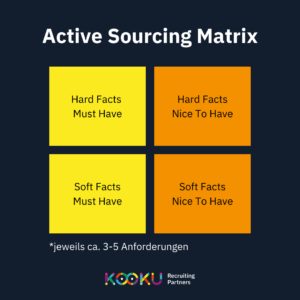Contents
Let’s face it: the days of having the perfect candidates lined up for your advertised jobs are over, right? Instead, companies today need to proactively search for suitable talent – and this is called active sourcing. But what does active sourcing mean for your company in concrete terms, which strategies are particularly promising and is it worth commissioning service providers with this task? A compact overview.
What is Active Sourcing? Meaning and definition
Active sourcing is a significant method when it comes to attracting new employees. Instead of waiting for the perfect candidates to come knocking (“passive sourcing”, e.g. by placing job advertisements), proactive recruiters go in search of suitable candidates themselves.
For active sourcing, for example Career platforms such as LinkedIn or Xing to find suitable profiles and contact them by message (“profile mining”). The goal of active sourcing is therefore to identify and inspire suitable candidates for the vacant positions and ultimately to successfully fill the vacancies.
When does active sourcing make sense?
Active sourcing is a particularly useful strategy for small and medium-sized companies without an established employer brand, as the shortage of qualified applicants is often particularly pronounced here. Nevertheless, active sourcing can be used in any company as long as they are open to novel ways of recruiting. Active sourcing can work in any industry as long as you match your target audience.
What are the active sourcing methods?
There are several active sourcing methods. Here we present four popular variants:
- Talent Pool: A talent pool is a predefined group of candidates who have already shown interest in your company, e.g. in previous applications or at networking events. This pool allows you to quickly access candidates who are already familiar with your brand when needed. This can significantly reduce response time when filling positions.
- Social networks: The aforementioned “profile mining” on platforms such as LinkedIn and Xing is one of the most powerful methods of active sourcing. Here you can search for profiles that match your requirements. By analyzing profiles, you gain valuable insights into the qualifications and professional backgrounds of potential candidates and can contact them individually.
- The CV Database Search: Online platforms and job portals such as Indeed, Experteer, Monster or StepStone often offer extensive databases of CVs. With a targeted search of these databases, you can find qualified candidates who are actively looking for jobs or open to new career opportunities.
- Referral Sourcing: Satisfied Employees are the best ambassadors for your company. Referral sourcing uses existing employees to refer potential candidates from their own network. These candidates are often qualified and a good fit for the corporate culture.
Which active sourcing strategies are particularly proven?
Choosing the right active sourcing strategy depends on your goals, industry, and the specific requirements of your open positions. Each of these methods requires a strategic approach and careful planning to successfully target and attract the best talent to your organization.
Among the various active sourcing methods, profile mining on social networks is currently particularly popular and has proven effective in many places. Here are some reasons why this method is often considered the best:
- Extensive data: Platforms such as LinkedIn offer extensive information on professional profiles, qualifications and professional backgrounds of candidates. This allows Active Sourcers to target candidates who are a perfect fit for open positions.
- Actuality: Profiles on job-related social networks are updated regularly. This means you have access to up-to-date information about candidates, including their current positions and professional interests.
- Direct communication: You can get in touch with candidates directly via the platforms, which enables quick and uncomplicated communication. This is particularly important in order to arouse the interest of candidates and to establish the first contact.
- Simple filtering: The search and filter functions on platforms such as LinkedIn allow you to target your search precisely to specific qualifications, experience and locations.
- Visibility: Profile mining on social networks allows you to present your company and your vacancies to a broad target group. This increases the visibility of your offers and attracts potential candidates.
Although profile mining on social networks is considered highly effective, it is important to note that other active sourcing methods can also be useful in certain situations.
Active Sourcing Process: 6 steps to success
Step 1 – Define the requirements profile: In the first step, it is crucial to define a clear requirements profile, including required qualifications, experience and skills.
 At Kooku, we use a matrix to distinguish between visible (hard facts) and not directly visible but still important (soft facts) requirements. Both for the Hard Facts as well as the soft facts are further differentiated between nice-to-haves and must-haves differentiated. This detailed yet concise approach allows us to precisely define the requirements for the position we are seeking and ensure that we identify the best possible candidates.
At Kooku, we use a matrix to distinguish between visible (hard facts) and not directly visible but still important (soft facts) requirements. Both for the Hard Facts as well as the soft facts are further differentiated between nice-to-haves and must-haves differentiated. This detailed yet concise approach allows us to precisely define the requirements for the position we are seeking and ensure that we identify the best possible candidates.
In particular, the hard facts/must haves are relevant for direct searches in social networks, because these are usually the three to five criteria that can be recognized at first glance in the candidate profile.
Step 2 – Select active sourcing channels: Choose the right business channels for your candidate search, such as LinkedIn or Xing. Depending on the position, other platforms or forums may also be considered. Think carefully: where do you best reach suitable candidates? Ask yourself:
- Which business networks do the potential candidates in my target group use most often?
- Are there specialized forums or online communities where professionals in this industry are active?
- Which channels offer the best opportunities to build an authentic relationship with potential candidates and capture their interest?
Step 3 – Find suitable candidates: Start the search and use your preparation to find candidates efficiently. The following also help Search strings.
Search strings are specially formulated search queries that help find precise results. These strings should contain keywords and criteria that match the requirements of the job. For example, you could search for specific qualifications, skills, experience or locations like “Java Software Developer Berlin”.
Step 4 – Write to candidates: The cover letter is crucial for arousing the candidate’s interest. Kooku CEO Mathias Mengel recommends formulating the cover letter directly in the message function of the respective business platform: “If you formulate a cover letter on a white sheet, it usually becomes very extensive and cerebral. That is inappropriate. A better approach: Click directly on “Write message” and write a short message using the AIDA formula.”
A cover letter according to the AIDA principle means:
- Attention: Attract attention with the headline/first sentence.
- Interest: Why is the position interesting for the candidate? What does he get out of it?
- Desire: Spark a desire to learn more about the open position – more salary, development opportunities, etc.
- Action: Encourage the candidate to respond directly or click on a job posting.
You can find out more in our
5 tips for appealing LinkedIn cover letters
.
Step 5: Create text memory
Once the first message is written, it now serves as a template for similar candidates. It is important that the cover letter always individually to the person and their current life situation. So it’s worth collecting different cover letters, for example, for candidates who are actively looking for a job and for candidates who are not. These messages can then be collected bit by bit, for example in a tool such as
OneNote
,
Clipboard Master
or
Notion
. In the future, the appropriate cover letters can be found here in just a few seconds.
The news writing process is often underestimated. That’s why working with professional recruiting agencies can be a relevant option for an effective recruiting strategy. Recruiting agencies have expertise in identifying suitable candidates efficiently and addressing them individually. This not only saves time, but can also be more cost-effective and increase the success rate.
Step 6 – Track results and optimize the processTo maintain an overview, increase speed and be able to follow up with candidates in a targeted manner, it makes sense to record the results, e.g. in an applicant management system (e.g. Workable or Recruitee, which are linked to LinkedIn) or simply in a spreadsheet. At Kooku, we use our own innovative recruiting dashboard for this purpose.
Want more insight into active sourcing or want to educate your employees on the topic? Take a look at our
Active Sourcing Training
over!
Active sourcing service provider
Find a few suitable candidates on LinkedIn, write them a nice message and the position is filled – sounds really easy. Unfortunately, it is not quite that simple. What is often overlooked is the time and effortbehind this supposedly simple task. Searching through profiles, writing persuasive messages, maintaining contacts and managing application documents – all of this requires time and resources. This is where active sourcing service providers come in.
“70% of candidates don’t respond immediately after the first message. Fortunately, there are proven structures and software tools that can support the recruiting process to track A-profile candidates. The sticking point: If there are no experienced recruiting experts in the HR department, the process can drag on considerably. Recruiting agencies offer an efficient alternative: we usually only need about 10-15 hours per week to achieve sustainable and speedy results.” – Mathias Mengel, Founder & CEO of Kooku
Service providers like Kooku specialize in the art of active sourcing and can help you find the best talent for your open positions. They have the necessary know-how to search specifically for the best candidates for you and to approach them professionally.
The benefits of working with active sourcing service providers are many. You can save time and resourcesoften have access to a broad broad network and are familiar with the latest trends and best practices in the field of active sourcing, which can give you a competitive advantage.
Of course, the selection of a suitable service provider is crucial. It is important to find a partner who understands your specific requirements and Customized solutions can offer. However, if the right choice is made, working with an active sourcing service provider can make the recruitment process much easier and increase the chances of attracting top-notch talent.
Feel free to contact us now to fill your open positions with our help in just a few weeks.
Advantages and disadvantages of active sourcing
Active sourcing undoubtedly offers some advantages that can be invaluable in talent search and selection. Nevertheless, there are also disadvantages.
Advantages:
- Access to passive candidates who are not actively looking for jobs.
- Time and cost savings through faster finding of a suitable candidate.
- Leveraging qualified talent from talent pools.
- Higher chances of finding the ideal candidate.
Disadvantages:
- Time required due to individual approach to candidates.
- Increased competition for passive candidates.
- Possible rejection by uninterested candidates.
Active Sourcing Examples
Theory is important. Often, however, it is only practice that makes sense. A few examples will show you how Active Sourcing methods are applied.
Scenario 1: Imagine you are looking for experienced software developers for your tech startup. You go to LinkedIn, type in specific keywords like “full-stack developer” and “Python expert,” and filter the results by location and experience. You’ll find talented professionals who match your requirements. Then, you send them personalized messages emphasizing your company’s interest and the benefits of hiring you. This is a classic example of profile mining on social networks.
Scenario 2: Let’s say your company already has a talent pool of previous applicants who weren’t selected at the time, but are still promising. You can actively nurture this talent pool by keeping in regular contact with candidates and informing them of new job opportunities. When a suitable position becomes available, you can reach out to those candidates directly and encourage a reapplication.
Scenario 3: You introduce a referral program in your company and encourage your employees to suggest talented candidates from their own network. These candidates already have the trust of an employee, which can make the recruiting process easier.
You see: Active sourcing is diverse and adaptable. It can be implemented in a variety of ways, depending on your goals and the resources you have available. The art of Active Sourcing is to choose the right strategy for your specific needs while maintaining human contact and professionalism. We at Kooku are happy to support you in this.





